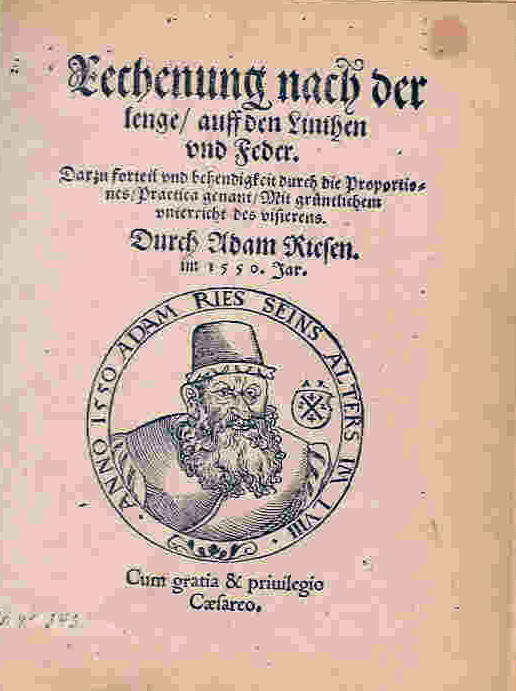Multiplication "Done according to Adam
Ries"
(Das Macht nach Adam Ries)

Learning multiplication facts is much easier than we think. The products x*y of two one-digit numbers x and y whose sum is more than 10, x + y > 10, can be computed by a simple procedure that is illustrated by the examples below.
Sum of two Product of their Their
numbers: complements: product:
7 3 7
+8 *2 *8
15 = 10 + 5 6 56 = 50 + 6
8 2 8
+8 *2 *8
16 = 10 + 6 4 64 = 60 + 4
6 4 6
+9 *1 *9
15 = 10 + 5 4 54 = 50 + 4
3 7 3
+9 *1 *9
12 = 10 + 2 7 27 = 20 + 7
4 6 4
+7 *3 *7
11 = 10 + 1 18 28 = 10 + 18
5 5 5
+6 *4 *6
11 = 10 + 1 20 30 = 10 + 20
6 4 6
+7 *3 *7
13 = 10 + 3 12 42 = 30 + 12
This procedure can be summarized as follows:
Add x and y, discard 10, and keep the units. This number of units gives you the “basic” number of tens in your product. Multiply the complements to 10 of x and y, (10-x)*(10-y). Add their product to the “basic” number of tens.
There are twenty facts x*y, where x + y > 10, that can be computed by this method. They are: 2*9
3*8, 3*9
4*7, 4*8, 4*9
5*6, 5*7, 5*8, 5*9
6*6, 6*7, 6*8, 6*9
7*7, 7*8, 7*9
8*8, 8*9
9*9
These twenty facts include all the “difficult” facts such as 7*8 and 8*9, and some easy facts such as 5*6 and 5*7.
This method is not based on a “trick”. It is based on the following two algebraic equalities:
x + y = 10 + (x + y - 10);
x*y = (x + y - 10)*10 + (10-x)*(10-y)
The first equality is used to add two one-digit numbers when their sum exceeds 10. The value x + y - 10 describes the excess over 10, namely the number of units in the sum.
The second equality allows us to reduce the computation of the product of two numbers to the computation of the product of their complements. This second formula contains the same expression, x + y - 10, as the first formula. And this fact explains the procedure that is shown above.
Of course the method also gives a correct answer for x*y when x + y < 10. But the algorithm is more complex and doesn't have any practical use. Here is an example when x = 4 and y = 3:
Sum of two Product of their Their
numbers: complements: product:
4 6 4
+3 *7 *3
7 = 10 – 3 42 12 = -30 + 42
This method of multiplication was shown in a very influential arithmetic book written in German by Adam Ries, titled Rechnung nach den lenge auff den Linihen und Feder, printed in Leipzig in 1550, pages 49 and 50.
A biography of Ries which includes a number of references in German can be found in Carpenter (1968), reprinted in Swetz (1994). (See also http://www.mathe.tu-freiberg.de/~hebisch/cafe/ries.html.)
Ries's book become so popular that saying that something was “Done according to Adam Ries” became synonymous with saying,“It is done correctly”.
References
Carpenter, D. (1965). Adam Riese. Mathematics Teacher 58, October, 538-42.
Swetz, D., Ed.
(1994). From five fingers to infinity: A journey through the history of mathematics. Chicago and LaSalle, IL:
Open Court Publishing.
Ries, Adam. (1550).
Rechenung nach der lenge auff den Linihen und Feder. Leipzig.
Webpage Maintained by Owen Ramsey
Lesson Index



